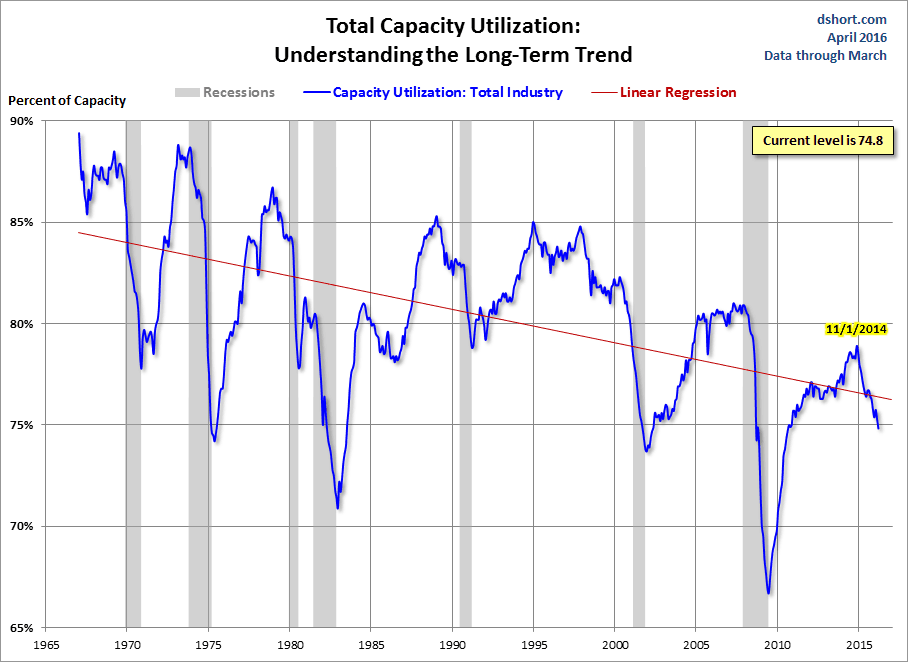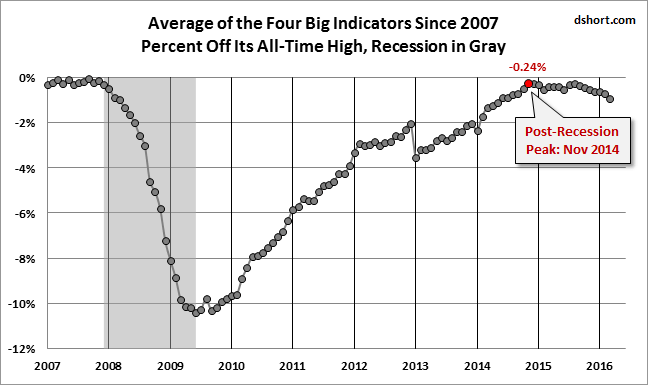Note: This commentary has been updated to incorporate the March data for Industrial Production.
Official recession calls are the responsibility of the NBER Business Cycle Dating Committee, which is understandably vague about the specific indicators on which they base their decisions. This committee statement is about as close as they get to identifying their method.
There is, however, a general belief that there are four big indicators that the committee weighs heavily in their cycle identification process. They are:
- Nonfarm Employment
- Industrial Production
- Real Retail Sales
- Real Personal Income (excluding Transfer Receipts)
The Latest Indicator Data
According to the Federal Reserve:
Industrial production decreased 0.6 percent in March for a second month in a row. For the first quarter as a whole, industrial production fell at an annual rate of 2.2 percent. A substantial portion of the overall decrease in March resulted from declines in the indexes for mining and utilities, which fell 2.9 percent and 1.2 percent, respectively; in addition, manufacturing output fell 0.3 percent. The sizable decrease in mining production continued the industry's recent downward trajectory; the index has fallen in each of the past seven months, at an average pace of 1.6 percent per month. At 103.4 percent of its 2012 average, total industrial production in March was 2.0 percent below its year-earlier level. Capacity utilization for the industrial sector decreased 0.5 percentage point in March to 74.8 percent, a rate that is 5.2 percentage points below its long-run (1972–2015) average
The full report is available here.
Today's report on Industrial Production for March shows a month-over-month decline of 0.6 percent (-0.59 percent to two decimal places), which was significantly worse than the Investing.com consensus of a 0.1 percent decline. The previous month's -0.5 percent decline was revised downward to -0.6 percent.
You may also like The Big Four Economic Indicators - Downtrend From 2014 Peak Continues
The chart below shows the year-over-year percent change in Industrial Production since the series inception in 1919, the current level is lower than at the onset of 16 of the 17 recessions over this time frame of nearly a century. The only lower instance was at the start of the eight-month recession at the end of World War II.
Capacity Utilization
The Fed's monthly Industrial Production estimate is accompanied by another closely watched indicator, Capacity Utilization, which is the percentage of US total production capacity being used (available resources includes manufacturing, mining, and electric and gas utilities). In addition to showing cycles of economic growth and demand, Capacity Utilization also serves as a leading indicator of inflation.
Here is a chart of the complete Capacity Utilization series, which the Fed began tracking in 1967. The linear regression assists our understanding of the long-term trend. We've highlighted the post-recession peak in November 2014.
The latest reading is well off its interim peak and slipped below the regression during the summer of 2015.
The Generic Big Four
The chart and table below illustrate the performance of the generic Big Four with an overlay of a simple average of the four since the end of the Great Recession. The data points show the cumulative percent change from a zero starting point for June 2009.
Current Assessment and Outlook
The US economy has been slow in recovering from the Great Recession, and the overall picture has been a mixed bag for well over a year and counting. Employment and Income have been relatively strong. Real Retail Sales have essentially gone nowhere for the past nine months, and Industrial Production has been in a recession since the end of 2014.
The chart below illustrates the average of the Big Four percent is off its all-time high. The post-recession recovery peaked in November 2014, sixteen months prior to the latest indicator data.










